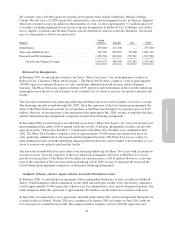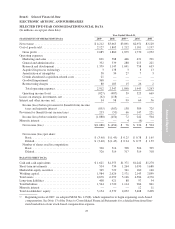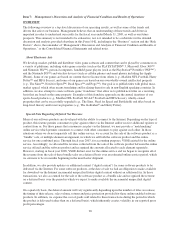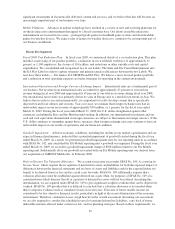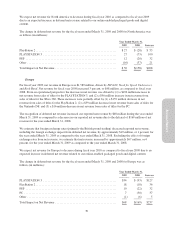Electronic Arts 2009 Annual Report Download - page 112
Download and view the complete annual report
Please find page 112 of the 2009 Electronic Arts annual report below. You can navigate through the pages in the report by either clicking on the pages listed below, or by using the keyword search tool below to find specific information within the annual report.year 2008, VSOE no longer existed for the online service to be delivered for certain platforms and all revenue
from these transactions is recognized over the estimated online service period. More specifically, starting in
fiscal year 2008, we began to recognize the revenue from sales of certain online-enabled packaged goods on a
straight-line basis over a six month period beginning in the month after shipment. Accordingly, this relatively
small change (from having VSOE for the online service to no longer having VSOE) has had a significant effect
on our reported results.
In addition, for some software products we also provide updates or additional content (“digital content”) to be
delivered via the Internet that can be used with the original software product. In many cases we separately sell
digital content for an additional fee; however some purchased digital content can only be accessed via the
Internet (i.e., the consumer never takes possession of the digital content). We account for online transactions in
which the consumer does not take possession of the digital content as a service transaction and, accordingly, we
recognize the associated revenue over the estimated service period. In other transactions, at the date we sell the
software product we have an obligation to provide incremental unspecified digital content in the future without
an additional fee. In these cases, we account for the sale of the software product as a multiple element
arrangement and recognize the revenue on a straight-line basis over the estimated life of the game.
Determining whether a transaction constitutes an online service transaction or a digital content download of a
product requires judgment and can be difficult. The accounting for these transactions is significantly different.
Revenue from product downloads is generally recognized when the download is made available (assuming all
other recognition criteria are met). Revenue from an online game service is recognized as the service is rendered.
If the service period is not defined, we recognize the revenue over the estimated service period. Determining the
estimated service period is inherently subjective and is subject to regular revision based on historical online
usage. In addition, determining whether we have an implicit obligation to provide incremental unspecified future
digital content without an additional fee can be difficult.
Product revenue, including sales to resellers and distributors (“channel partners”), is recognized when the above
criteria are met. We reduce product revenue for estimated future returns, price protection, and other offerings,
which may occur with our customers and channel partners. Price protection represents the right to receive a credit
allowance in the event we lower our wholesale price on a particular product. The amount of the price protection
is generally the difference between the old price and the new price. In certain countries, we have stock-balancing
programs for our PC and video game system software products, which allow for the exchange of these software
products by resellers under certain circumstances. It is our general practice to exchange software products or give
credits rather than to give cash refunds.
In certain countries, from time to time, we decide to provide price protection for our software products. When
evaluating the adequacy of sales returns and price protection allowances, we analyze historical returns, current
sell-through of distributor and retailer inventory of our software products, current trends in retail and the video
game segment, changes in customer demand and acceptance of our software products, and other related factors.
In addition, we monitor the volume of sales to our channel partners and their inventories, as substantial
overstocking in the distribution channel could result in high returns or higher price protection costs in subsequent
periods.
In the future, actual returns and price protections may materially exceed our estimates as unsold software
products in the distribution channels are exposed to rapid changes in consumer preferences, market conditions or
technological obsolescence due to new platforms, product updates or competing software products. For example,
the risk of product returns and/or price protection for our software products may continue to increase as the
PlayStation 2 console moves through its lifecycle. While we believe we can make reliable estimates regarding
these matters, these estimates are inherently subjective. Accordingly, if our estimates changed, our returns and
price protection reserves would change, which would impact the total net revenue we report. For example, if
actual returns and/or price protection were significantly greater than the reserves we have established, our actual
results would decrease our reported total net revenue. Conversely, if actual returns and/or price protection were
significantly less than our reserves, this would increase our reported total net revenue. In addition, if our
estimates of returns and price protection related to online-enabled packaged goods software products change, the
amount of net deferred revenue we recognize in the future would change.
32



